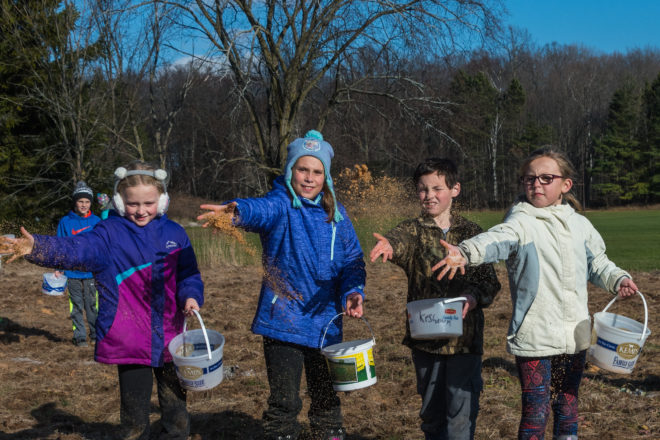Elementary Students Create New Prairie Ecosystem at Southern Door Schools
- Share
- Tweet
- Pin
- Share

Students at the Southern Door Elementary School spent the cool and sunny day on Nov. 29 planting a sea of prairie grasses and pollinators next to the school forest. The project, commissioned by the district’s School Forest Committee, will give students the opportunity to watch prairie grasses and wildflowers grow along with their own growth through the district.
“I think we were just interested in establishing another habitat on our school grounds so we thought a prairie would be a nice way to use the space out here at the edge of the forest,” said Jessica Marchant, first grade teacher and member of the committee. “The kids can see how pollination and the ecosystem can work together.”
With help from Chris Plzak, forester with the Department of Natural Resources, students in first and third grade spread a mix of prairie grass and wildflower seeds throughout the plot next to the school forest.
“In state statute we [the DNR] are responsible for managing school forests,” said Plzak, who also serves on the committee. “DNR foresters are the ones who provide assistance to them no charge. I live in the Southern Door district so I’ve taken a little bit more of a grab to this group, being it’s in my backyard basically.”

Photo by Len Villano.
Before setting the antsy students loose to throw their seeds to the wind, Plzak explained the importance of prairies and pollinators. Pollinators are the only reason we can eat cereal for breakfast, he explained, which, by show of hands, would have affected almost all of the kids’ morning routines.
“The idea came up about a year ago with our crew and we put the wheels in motion and started doing some planning sessions,” said Plzak. “We wanted to involve the kids in pretty much every aspect of this project.”
The ecology education didn’t stop at planting seeds. Fifth grade math students used aerial snapshots of the plot to map out and grid evenly spaced plots for the younger students to plant. The first grader’s lesson on the lifecycle of a monarch butterfly provided them with the knowledge they will apply to the prairie as milkweed begins to grow during the next few years.
“The fifth grade teachers have really applied this in their classrooms,” said Marchant.
“It gives them some sense of ownership in the project,” added Plzak.
The prairie will likely lay dormant throughout 2017, much to the despair of the excited students. Plzak explained that planting in the winter would allow the seeds to develop a strong root system when the sun comes out in the spring. After a year of dormancy, wildflowers of all colors will dot the prairie, bringing with them a host of birds, bugs and bees.
While many schools across the state have their own school forest, a school prairie is a rare find.
“I think Southern Door is very fortunate to have the forest resource in the backyard and now adding a prairie I think there’s a rare opportunity for rural districts,” said Marchant.



